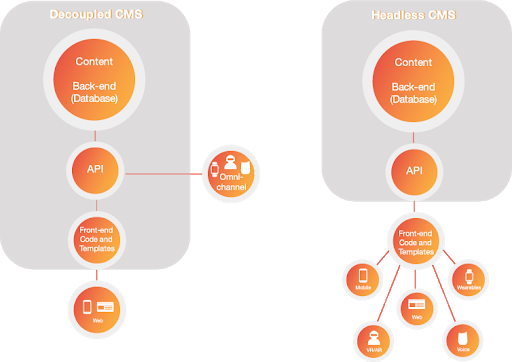What is a Headless CMS?
Simply put, a headless CMS is a content management system that manages and organizes content without a connected front-end or display layer. The headless CMS is where all of your content and assets live. You use a content API to distribute that content to anywhere and everywhere you need it — your website, your mobile app, your email marketing, your CRM, etc.
Here’s what that means in practice. Let’s call the part of the CMS that cares about the presentation the “head,” akin to how we care about the presentation of our physical heads.

The benefits of a headless CMS are immediate and compelling:
- Instead of having to implement multiple, parallel content management system instances, e.g., to support web and mobile channels, a single headless CMS instance can serve unlimited digital channels.
- A single source of content, such as a product description for an online catalog, can automatically adapt to its publishing environment and present itself optimally for its destination.
- The separation of code and content in a headless CMS makes life easier for content editors, who can ignore the code and exclusively focus on the content for which they are responsible.
- Developers, meanwhile, can use all the latest tools and frameworks to bring content experiences to life on any modern platforms, without being locked into a proprietary language or other limitations of a particular content management system.
- Content delivered via APIs is much easier to integrate, manipulate and distribute, reducing the time it takes to create content-driven experiences, including sites and apps.
Why Do We Need a Headless CMS?
The headless CMS is an essential piece of technology because we live in an omnichannel world. The content that enterprises create for their website also needs to appear on apps, integrations, newsletters and more. Managing a duplicate copy of that content for multiple channels is a nightmare of inefficiency.
If your company makes an update to a product description, that update shouldn’t be copied and pasted in 20 different systems. You should be able to make the update in one centralized location and push the change out to all of the places where it matters.
That’s the power of a headless CMS.
It works as one central source of truth for all of your company’s content and assets. It gives you one place to manage, edit, update and publish that content.
Download the Ultimate Guide to Headless CMS to see how an API-first, headless CMS can work for your business.
Headless vs. Legacy CMS
Following the early years of the Internet, the CMS emerged as an essential tool that allowed businesses to manage their website more easily.
These content management systems excelled at the creation of websites, firmly establishing the world’s first digital channel (i.e., the Web) as a vehicle to distribute digital content to growing online audiences.
Shortly after that, blogging became popular, and some of the most well-known CMSes emerged into the market — Drupal, WordPress, et al. WYSIWYG (“What You See Is What You Get”) editing became a popular content management system feature because it allowed for faster website creation and a quick QA process for published content.
But this class of CMS has been confronting an existential challenge in the modern world.
Connected devices have driven an explosion in the number of channels, screens and formats for content. Any single piece of content can be restructured and deployed in dozens or hundreds of contexts across a myriad of devices.
WYSIWYG editors are not built to handle this level of complexity.
Legacy CMS solutions handle 1:1 content deployment to a single web page. These systems can't handle the omnichannel world of mobile sites, apps, touchscreen displays, Alexa integrations and smartwatch apps.
All of this presents a significant challenge for organizations using 20-year-old content management system technology.
Where once it was advantageous to optimize for a single digital channel, suddenly this highly streamlined CMS architecture is insufficient for a world in which content has to be available on many digital channels.
Complete the form below to download the Ultimate Guide to Headless CMS series to see how an API-first, headless CMS can work for your business.
In these guides, you'll learn:
The differences between headless vs. decoupled vs. traditional CMS
The pros and cons of using different types of traditional CMSes versus using a headless CMS
The best use cases for a headless content management system